WHY SHOULD I VISIT SOUTH AFRICA?
Here are the top five reasons why you should visit South Africa:
Here are our top five reasons why you should visit South Africa:
- Cape Town – the iconic Table Mountain, great cuisine, and beautiful beaches
- Greater Kruger National Park – animals, animals, and more animals
- Winelands of the Western Cape – some of the world’s best wine estates
- Garden Route – South Africa’s lake district
- The Drakensberg – Barrier of spears
In South Africa, you are truly spoilt for choice. It is a cliché, but South Africa is an entire world in one country. If you are here for adventure, cuisine, mountains, deserts, beaches, wildlife, wine, flowers, birding, hiking, whale watching, cycling, golfing, culture, diving, and hot air ballooning, or all the above, you have come to the right country.
As I write this, I face the same challenges you will in that I am spoilt for choice and have to decide what to include and what to leave out. This is my way of saying that this is not an exhaustive guide to South Africa, but hits the high notes. There is so much more, and more…
When Is the Best Time of The Year to Visit South Africa?
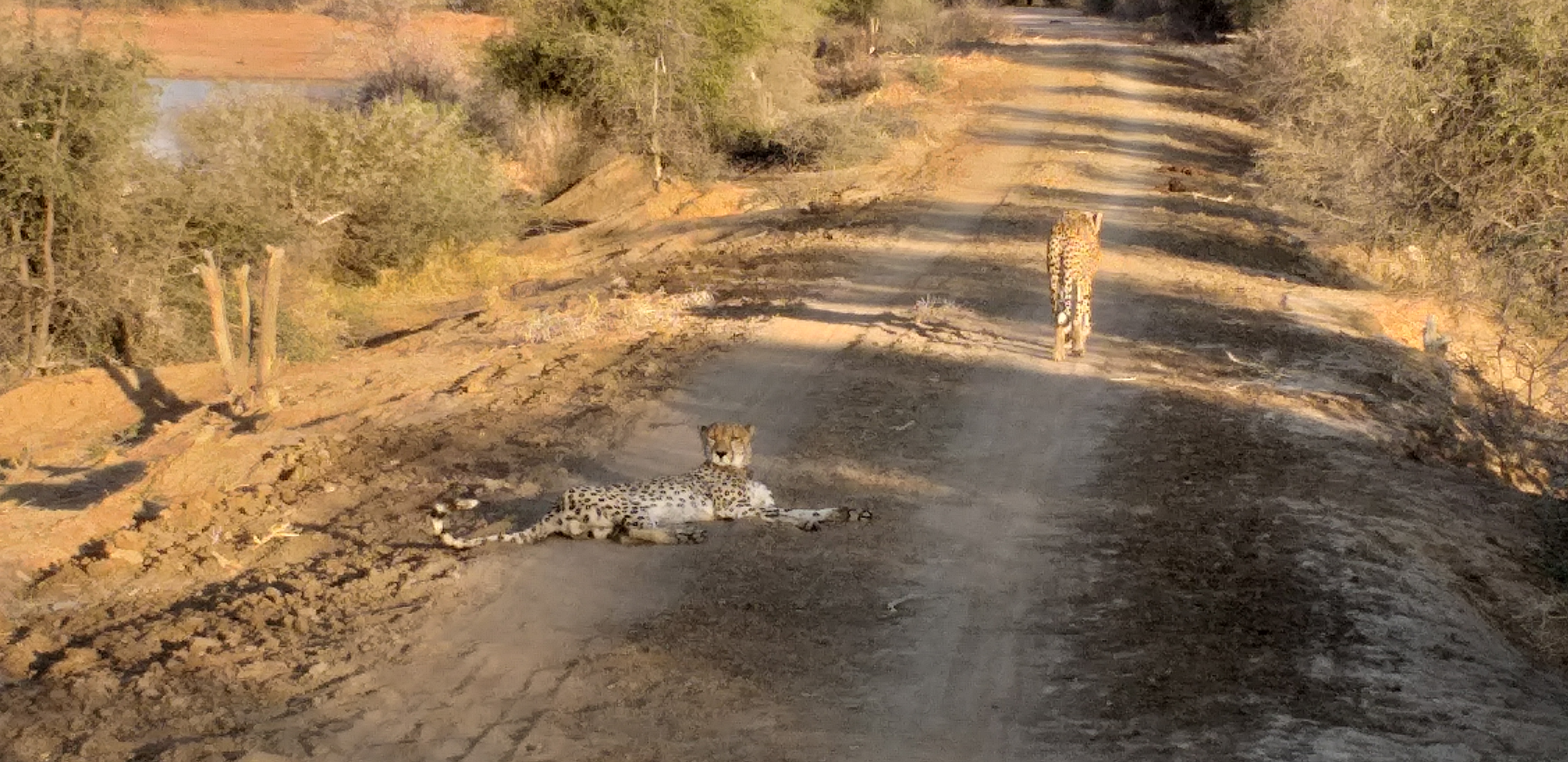
Cheetah, one of Afric’s most endangered species
There is single answer. It depends on what you want to experience and where you want to be.
In All Areas but the Winter Rainfall Areas of the Western and Eastern Cape:
The best time for game viewing in the central and northern provinces is from May to October. This is the dry season, when the grasses are at their lowest, trees have lost their leaves, and wildlife is more easily spotted.
The best time for a beach holiday, hiking, birding, diving, adventure, golfing, and enjoying the scenery is during the summer and autumn months, namely November to April. While it does rain, the rain is normally in the form of thunderstorms, which soon give way to bright sunshine.
In the Winter Rainfall Areas of the Western and Eastern Cape:
The best time for game viewing is during autumn, summer, and spring, namely October to April. This is also the best time for a beach holiday. Hiking, birding, diving, adventure, golfing, and enjoying the scenery is during the summer and autumn months, namely November to April.
The far northern western parts of the country are uncomfortably hot during December, January, and February, and are best avoided during this period.
For birders, the best time is during the wet summer months, namely November to March.
Which places should I include in my visit?

Table Mountain after the rain
With so much to choose from, it largely depends on your interests and amount of time you have available. Stays from a few days to two months are not uncommon.
I will restrict my suggestions to a stay of two weeks, and also differentiate between first timers and repeat visitors.
For First Timers:
I recommend you include Cape Town, the Winelands, the Garden Route, and a safari. The safari can be in the Greater Kruger or Madikwe.
For repeat visitors:
I would look at combining a safari in KwaZulu-Natal combined with the Drakensberg Mountains and/or the battlefields and the beautiful beaches and warm seas of the KwaZulu-Natal coast.
OR
A safari in the Waterberg or Pilanesberg combined with stays in the mountains of Mpumalanga and a safari in the Greater Kruger area.
OR
A safari in the Eastern Cape combined with the Karoo and Garden Route.
OR
A safari in the Western Cape combined with the West Coast, Augrabies, and Kgalagadi. This would be of particular interest in August/September during the flower season on the West Coast.
Other special places include Route 62, the Cederberg, the Eastern Cape Coast, the Natal Midlands, Nambiti, the Klein Karoo, northern Kruger, the Soutpansberg, and Mapungubwe.
How long should I visit South Africa for?
I would recommend a minimum of ten days, but depending on your available time and budget, you could easily stay up to four weeks. South Africa is a great launching pad for extending your trip to the special countries around it.
What is the weather like in South Africa?

Table Mountain after the rain
South Africa has two distinct climate zones, namely summer and winter rainfall areas. The climate in this country varies from the sub-tropical north and east to the dry and arid Karoo, Klein Karoo, Kalahari, temperate highlands, and the Mediterranean climate of the Western Cape.
The summer rainfall areas have rain between November and April in the form of thunderstorms, but some areas have periods of rainy/cloudy weather that can last for a week or more. Summer temperatures are generally high, but cooled somewhat by cloud cover. Winter temperatures on the high lying areas can go below 0°C, but in most places, days are sunny and warmer, particularly along eastern coastal regions. Snow is possible on the highest mountain areas, but this is sporadic.
In the winter rainfall area, rain falls between May and September. During this time, temperatures are mild to cold. The summer is hot and sunny.
With so many distinct climate zones, the above is a broad indication, and it can vary considerably depending on the area you are visiting.
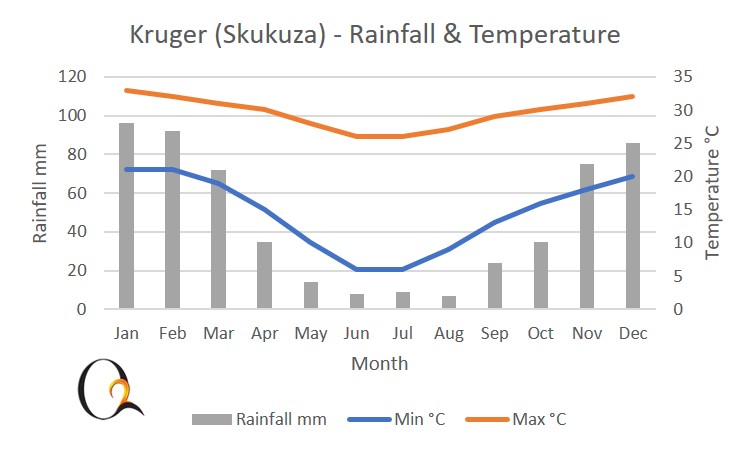
Southern Kruger and lowveld climate chart
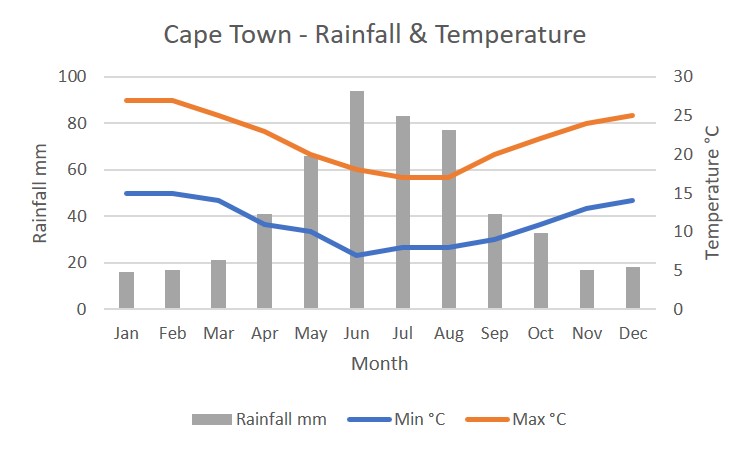
Cape Town and Western Cape coastal climate chart

Johannesburg and central plateau climate chart
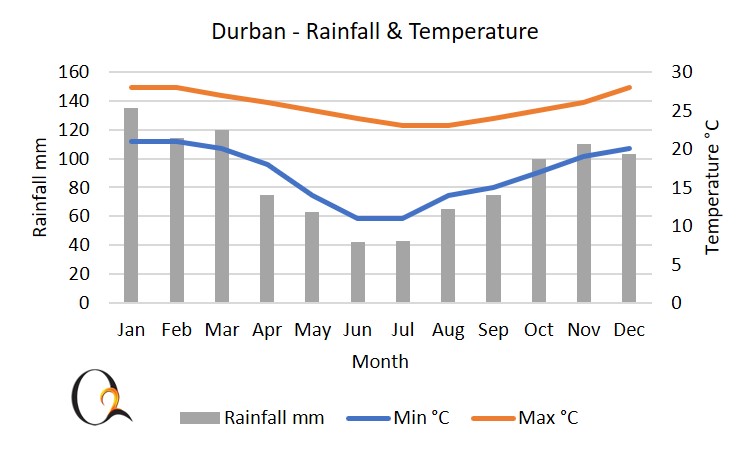
Durban and KZN coast climate chart
Do I need a visa to travel to South Africa?
Most countries require a visa to visit South Africa. Some nationalities can get a visa on arrival, but the majority of countries need to apply in the home country. Please check before travelling whether you require a visa or not.
What are the health requirements for South Africa?
With the exception of the far north-eastern part of South Africa and KwaZulu-Natal, where the risk of malaria is medium to high, South Africa is mostly malaria free. The malaria areas are more risky to visit in the wet summer months – November to April. Anti-malaria medication is recommended, and you should consult your doctor in this regard. To minimise the risk of contracting malaria, wear long trousers and cover your arms in the evening, and apply mosquito repellent.
Yellow fever vaccination is required if you are coming from an endemic country. The following vaccinations are recommended, but not compulsory:
- Hepatitis A & B;
- Typhoid; and
How can I travel around in South Africa?
South Africa has a very well-developed road network, and getting around is relatively easy. While local means of transport are available everywhere, I will only include those modes of transport that are suitable and safe for tourists.
For the more budget conscious, most main centres are served by luxury buses. Car rental is available in most major cities and at all airports. Scheduled domestic flights between the major cities are frequent and reliable, and light aircraft transfers and charter flights to virtually any part of South Africa are available. Transfers to and from and in most of the tourist centres can include standard sedans or luxury vehicles. Ultra-luxury trains regularly link Cape Town, Johannesburg, Pretoria, and Durban. Metered taxis are available in the main cities, as is Uber and its competitor Bolt (formerly known as Taxify).
TOP TOURIST ATTRACTIONS
I am going to approach this section from the perspective of a tourist, who may well be interested in the history, size, and details of these attractions to enhance their stay, but who need quick information to help them decide what to include in their trip to South Africa. This is my perspective on the various destinations covered here.
Kruger National Park

Elephant near Lukimbi
The Kruger National Park is the most famous of South Africa’s National Parks, and is just under 2 million hectares in size. It is divided into two very distinct zones, the northern section and the rest of the park, which are separated by a huge Mopani tree forest. The rest of the Kruger National Park can loosely be categorised into the central and southern sections.
When going on safari, the main purpose is to see and experience the amazing and unique wildlife on offer. A safari in the southern park of the park is, in my opinion, for the most part, more productive. This is as a result of the perennial Sabie and Crocodile rivers that flow through and along the border of this section. As this area is water scarce, it stands to reason that animals would prefer to be near water, particularly during the hotter and dryer periods of the year. This is the main reason that this part of the park is most productive.
When you move to the central parts of the park, it becomes hotter and dryer and rivers are seasonal. This area can be quite productive (for example the area around Satara Rest Camp), as there are numerous water holes and a handful of dams.
The northern part of the Kruger is quite different in that it starts to become more mountainous; the vegetation changes and the Mopani belt seems to act as a natural barrier that some species prefer not to cross. While the Big 5 can be seen here, it is more of a challenge, and safaris are not so much about chasing after the Big 5, but rather appreciating all species and enjoying the rugged scenery. This area is excellent for walking safaris, which is an exciting way to experience the African bush.
Besides the rest camps, The Kruger National Park has allocated some private concessions, and it is here that you can experience the luxury of a private lodge and the wildlife of the famous Kruger.
In my opinion, game viewing in the Kruger is more challenging than East Africa and other reserves in South Africa, as the bush can be thick – especially in summer – and the grasses high, making it difficult to spot game. It is a distinct advantage, when going on safari in the Kruger, to stay at the luxury lodges that do their game drives in high-riding 4×4 safari vehicles and have access to a larger road network than self-driving in the Kruger provides.
The Kruger is world-renown for large herds of game, which include buffalo, elephant, and impala. Wild Dog and Cheetah are also to be seen in the park, but they are more difficult to spot than elsewhere due to the vastness of the park and the relatively small road network.
Greater Kruger area (including Sabi Sands, Timbavati and much more)

One of the Big 5 in the Greater Kruger area
Adjacent to the Kruger National Park are private reserves that, for the most part, do not have fences between them and the Kruger National Park, allowing the animals to move freely in and out.
These private reserves provide some of the most beautiful safari lodges in the world, offer some of the best service levels in South Africa, have an outstanding level of guidance throughout, have a bigger game road network than the Kruger, and provide some of the world’s best safari experiences.
The Sabi Sands Game Reserve is the most famous of these reserves, particularly for its predators. It is almost a given that for a three-night stay, you will encounter all of the Big 5, some more than once. The reason for this is that the Sabie River runs through the reserve, attracting all manner of game, and it arguably has the most extensive road network in the country, allowing the visitor to get close to game. This, together with the high standard of guiding, is the reason that the Sabi Sands is so popular. I have noticed that the Sabi Sands, while excellent for predators, is not the best destination for large herds of buffalo and elephant, as well as abundant general game.
The Timbavati Private Game Reserve, to the north of the Sabi Sands, is less popular than the Sabi Sands, and as a consequence, has fewer lodges, allowing for a more private experience. It essentially provides the opportunity to see the same game as the Sabi Sands, as there are no fences separating them, or them and the Kruger. I have had some of my best sightings of the leopard in the reserve and have seen larger herds of buffalo than in the Sabi Sands, but this is most probably the luck of the draw.
Surrounding the Timbavati are the Manyeleti Game Reserve, Balule Nature Reserve, and The Klaserie Private Nature Reserve. It is impossible to tell where these reserves start and end, unless this is pointed out to you, as they all form parts of the whole, which includes the Sabi Sands and the Timbavati. These reserves are becoming more popular of late, as they offer great game viewing – but at an overall lower cost than the Sabi Sands – are less congested and are also superior for walking safaris.
Other private reserves in this area include the Thornybush Private Nature Reserve, Kapama Private Game Reserve, Karongwe Game Reserve, and a recent newcomer named the Blue Canyon Conservancy. These private reserves, while fenced, are large and offer excellent game viewing, including the Big 5. Some of my best safaris were experienced here, particularly the Thornybush and Kapama, which are more established and better stocked.
Cape Town
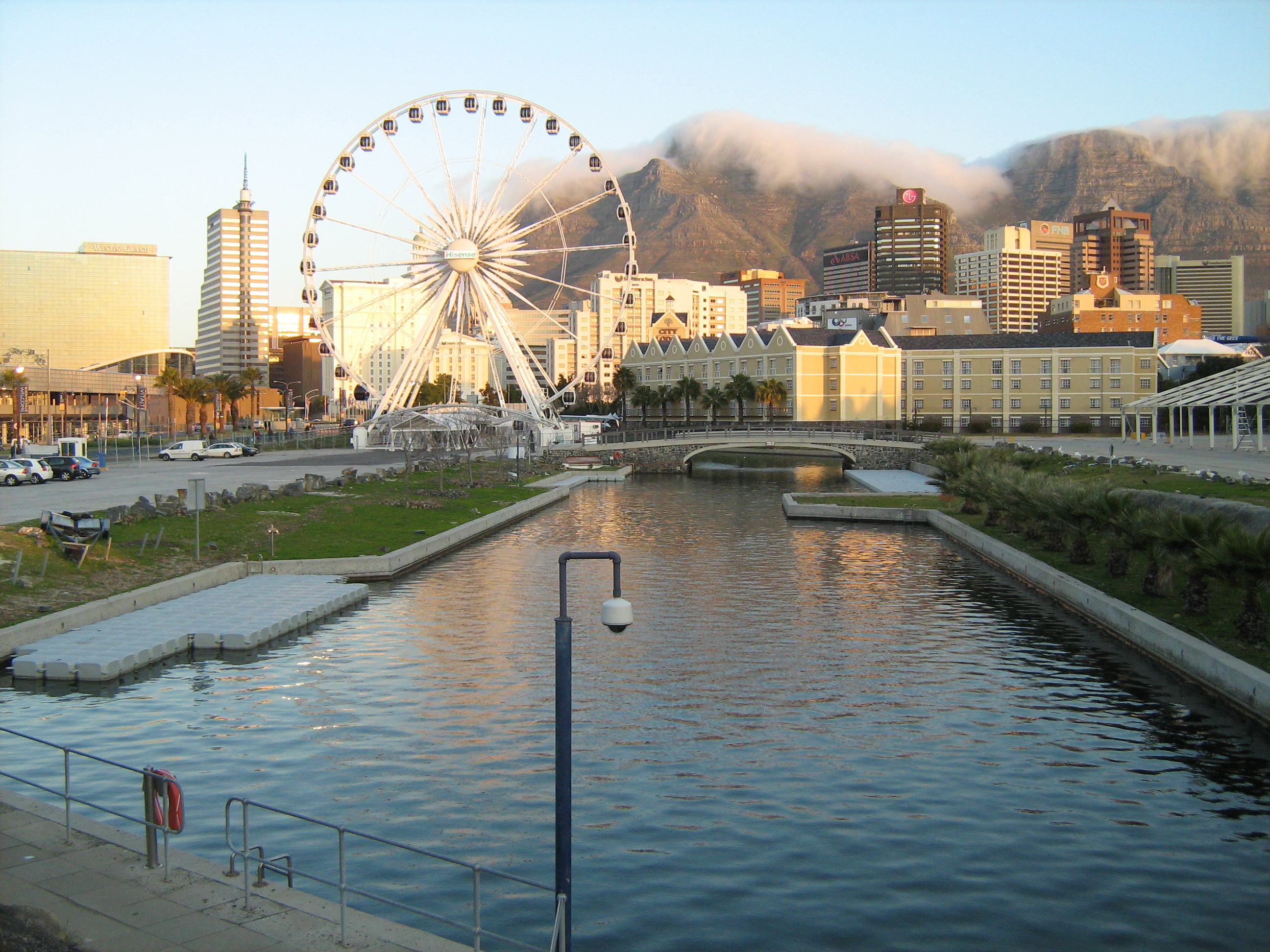
Victoria & Alfred Waterfront in Cape Town
When you mention Cape Town, the first image that springs to mind, for most people, is the iconic Table Mountain. It is a must see in South Africa, as from the top of the mountain, it provides magnificent views of Cape Town, the blue Atlantic Ocean, and the rest of the mountain range, including the Twelve Apostles, and on a clear day, the mountains close to the Cape Peninsula. The mountain can be accessed by cable car, or for the more adventurous, by hiking up to the top, which is mildly challenging for the fit.
Cape Town is right on the Atlantic Ocean and offers some beautiful beaches, but be warned that the water is cold, as it comes straight from the Antarctic.
Cape Town is trendy. It has a wide variety of restaurants, bars, entertainment venues, and theatres all competing with each other to provide the tourist and cosmopolitan local with the most innovative, different, unique, and atmospheric options to spend their time.
The history of Cape Town is rich and varied, and this can be experienced when navigating its narrow roads, dating back to the colonial era; viewing its buildings; and visiting its historical sights (Robben Island, District Six, Castle, Company Gardens, etc.). One of the best and most exciting ways to visit all these sights is by taking the topless buses that offer four different routes throughout the city.
Another reason to visit Cape Town is for its fine food. It is the “foodie” capital of South Africa (this may be disputed), and in its countless restaurants, coffee shops, and eateries, you can enjoy cuisine with a local flavour, fusion cuisine, standard favourites, and the most exotic of dishes.
If you want to include nightlife in your trip, Cape Town is where you should be.
Cape Town is a “multi-purpose’’ destination, and offers something for virtually everyone, except maybe the peace and quiet of the African bush.
Garden Route

Along the Garden Route
The Garden Route is so named after the Cape Floristic Region, which it encompasses. One of six floral kingdoms in the world, it boasts over 9000 species of plant, of which about 70% are found nowhere else. Locally, it is referred to as “fynbos”. Declared by UNESCO as a biosphere reserve, this area is one of the biodiversity hotspots.
It is not quite clear where the Garden Route begins and ends, but as a rule of thumb, when travelling along the coast, it starts in Mossel Bay and ends in the Tsitsikamma. It encompasses a narrow band along the coast, but some consider parts of the Klein Karoo, also covered in Fynbos, as part of the Garden Route. This would add places like Oudtshoorn, de Rust, and Ladismith.
The Garden Route boasts some of the best beaches and coves on the southern Cape coast, the lake district of Wilderness to Knysna, lagoons, mountains with some spectacular mountain passes, and indigenous forests. The areas offer spectacular hikes, the best of which must be the Otter Trail.
The area, one of South Africa’s most beautiful, has something for everyone. With accommodation both in remote wilderness areas, in town, and on the coast, you are spoilt for choice
Activities include golf, bungee jumping, hiking, horse riding, kayaking, canoeing, black water tubing, boat trips, whale- and dolphin-watching, ostrich riding, meerkat tours, paragliding, birding, and surfing to name but a few.
I would recommend that you spend at least four days travelling along the Garden Route, but ten to fourteen days would not be too long, especially if you want to relax and soak up its beauty.
Route 62
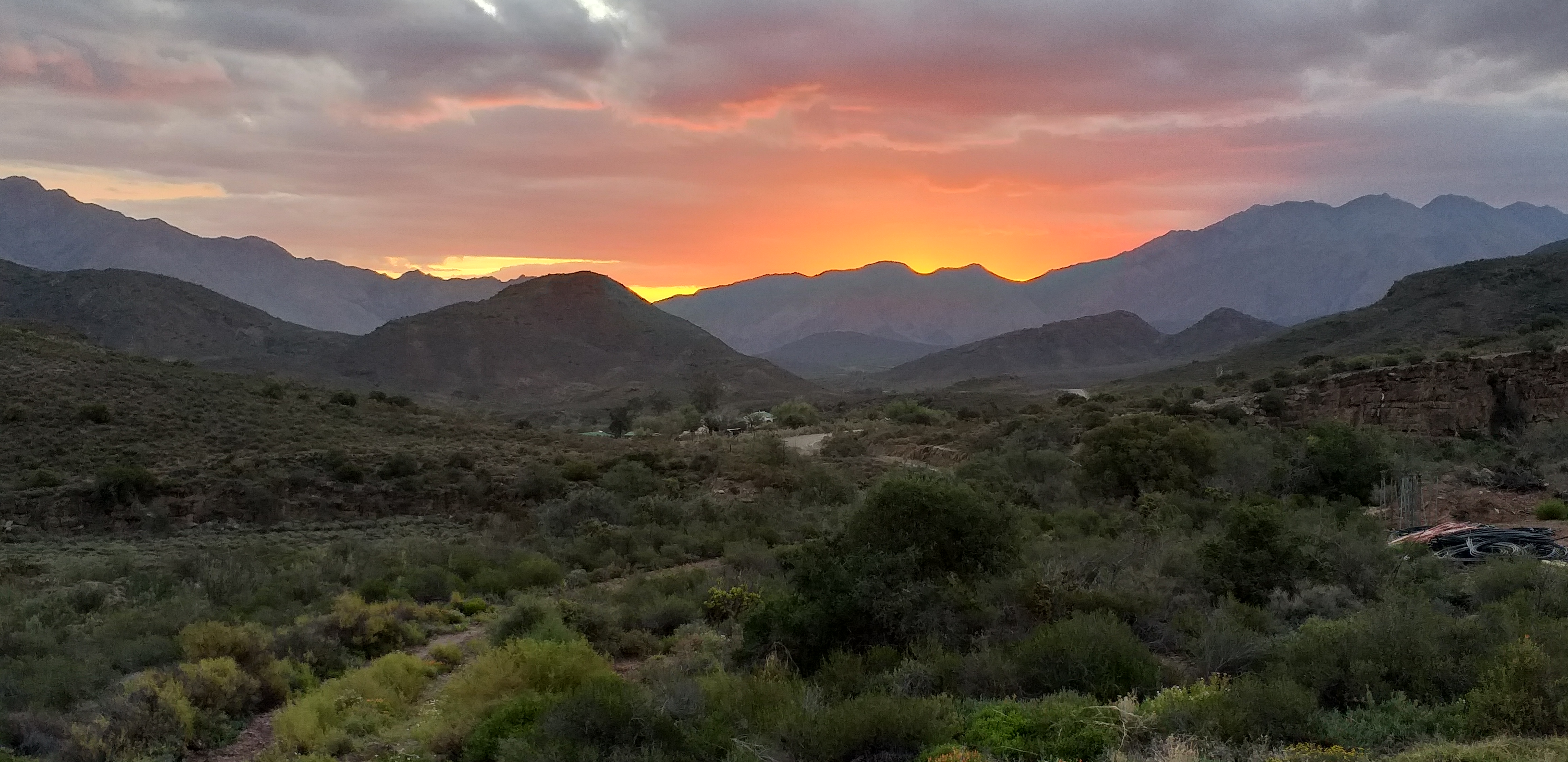
Montagu on Route 62
This is the alternative route from Cape Town to Port Elizabeth to the main highway that runs further south. It is by far more scenic, travelling through spectacular mountain passes, along the longest wine route in the world, through quaint towns and villages, and offers that off-the-beaten-track journey that restores the soul. While shorter in distance than the N2 (National Highway 2), it will take you longer, as you will be tempted to stop all along the route to experience the sights, sounds, and cuisine that is unique to this area.
West Coast

Flowers displays in the West Coast National Park in spring
The West Coast of South Africa is most well-known for the spring flower displays during August and September. Quaint fishing villages like Paternoster, surfing hotspots like Eland’s Bay, kitesurfing on Langebaan Lagoon, and the fynbos and flower displays of the West Coast National Park are but a few highlights to be experienced when travelling this route. The home of Rooibos tea, the Darling wine route, and the Cederberg Mountains, the West Coast is easily accessible from Cape Town and finds itself amongst the “roads less travelled”, making it a relaxing and rejuvenating option.
Northern Cape
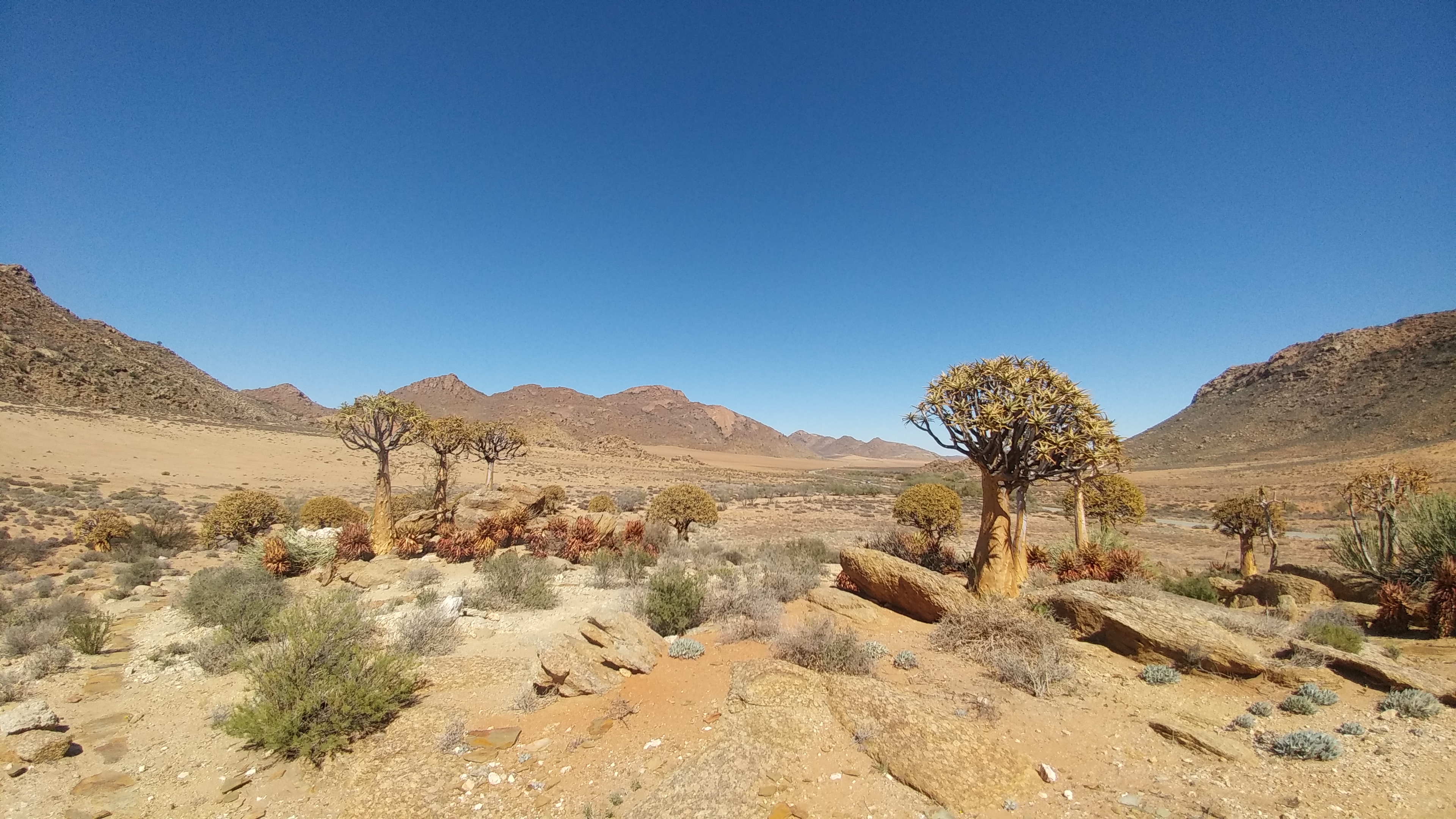
Typical Northern Cape scene
The Northern Cape is the most sparsely populated and largest province of South Africa. It is dominated by the Kalahari Desert, but has South Africa’s longest river, the Orange River, running through it. Except for the narrow band along the river, it is mostly arid and hot and not suitable for agriculture.
The famous Namaqualand, with its incredible floral displays during August and September, can be found near Springbok. Other places of interest include Kimberley and the Big Hole, which was the centre of the diamond rush in the 1860s; Augrabies Falls; the Richtersveld National Park, which together with the Fish River Canyon in Namibia, form the Richtersveld -Ai -Ais Transfrontier Park and the Kgalagadi Transfrontier Park, which it shares with Botswana. !Xaus Lodge, adjacent to the Kgalagadi National Park, is the only Dark Sky lodge in Africa and the best place to go stargazing. Also of interest is the massive astronomical observatory in Sutherland.
As it gets extremely hot in summer (up to 53°C), the area is best visited during other times of the year. The Augrabies Falls is often best between February and April, but the stark scenic beauty of the area can be enjoyed all-year-round, as it has so little rain, and days are sunny and warm to hot. As is typical for desert regions, the morning and nights can, at times, get very cold.
Madikwe Game Reserve

Wild Dogs in the Madikwe
Malaria free! This is one of its claims to fame. The Madikwe is one of conservation’s success stories. Originally a network of farms, the government started to rehabilitate the land, and have largely managed to restore the Madikwe Game Reserve to its original vegetation and beauty. Home to the Big 5, plus cheetah and wild dog, South Africa’s fifth-largest game reserve is one of the best safari destinations in South Africa and one of my favourites.
With a wide variety of luxury lodges to choose from, Madikwe offers comfort and superb game viewing. As no self-drivers are allowed, your safari will, unlike the Kruger National Park, be exclusive.
Over the years, more and more tourist lodges have been built, resulting in it being quite busy. The animal sightings are, however, well-managed by the guides, who try to steer clear of other vehicles for the most part to give you the best safari experience possible.
I have found that the variety and numbers of game, as well as the frequency of predator sightings, are some of the best in South Africa and allows the Madikwe to give an excellent overall safari experience.
Pilanesberg Game Reserve & Sun City

Elephants on the road in the Pilanesberg
The Pilanesberg is a series of three rings of mountains, which were formed over eons by volcanic eruptions and the crater collapsing, until only these three rings of mountain remained. It is estimated that the volcanic mountain was over 7000 m high.
The whole mountain range with its valleys and hollow centre is now a game reserve with the Sun City hotel and entertainment complex tucked away in the south. The Pilanesberg Game Reserve is home to the Big 5. It is a popular wildlife destination for people from Gauteng, as it is only two hours away from Johannesburg and slightly less from Pretoria. As it is reasonably small, it can become quite congested, especially during weekends and holidays, as it does allow self-drivers.
The Game Reserve has a few luxury lodges, which are quite reasonable in price, and offer the tourist the luxury and service of any other private lodge in South Africa.
The Pilanesberg is perfect for a tourist who has very limited time and wants to taste the safari experience before moving on.
The Sun City resort complex and the famous Palace of the Lost City offers a modern take on the old African empires of the past. With a range of hotels, from 3- to 5-star, accommodation can be tailored to fit your budget. With nightly entertainment, a casino, a crocodile park, a water park, a myriad of restaurants, and two exceptional golf courses, Sun City offers a busy holiday for the whole family.
Waterberg Area in Limpopo

Marataba Reserve in the Waterberg
The name Waterberg is due to this mountain range being a major water catchment area. The mountains are the source of four main rivers and a myriad of smaller streams. A UNESCO biosphere reserve, it seeks to preserve the savannah biome, which boasts over 5500 species of plants, of which over 40% are endemic to South Africa.
The abundance of water in the area attracted wildlife, which were hunted and poached out over the years. The Welgevonden, the adjacent Marakele National Park and Marataba Game Reserve also tell of a conservation success story, similar to the Madikwe, where farms have been rehabilitated to natural bush and animals reintroduced.
As the populations are still growing and the land still recovering in some places, it is not yet one of South Africa’s prime safari destinations. Game numbers are good, but cannot compare with the likes of the Greater Kruger and Madikwe. This being said, it is one of the most spectacular settings in South Africa to enjoy a safari, as the mountain range with its cliffs, rivers, and general topography is unique and beautiful.
Panorama Route

Lisbon Falls on the Panorama Route
The Panorama Route is so named due to the multitude of “panoramas” that you can experience when travelling along the route. These Panoramas include Blyde River Canyon (world’s third-largest Canyon), God’s Window, from where you can see large parts of the lowlands right to the Kruger National Park and views of the Sabie Valley. The route also offers beautiful waterfalls, namely Lisbon Falls (my favourite), Mac Mac Falls, Panorama Gorge Falls, Berlin Falls, Bridal Veil Falls, Maria Shires Falls, Horses, Lone Creek Falls, Forest Falls, and Sabie Falls.
With spectacular mountain vistas all along the route, huge green forests, towns tucked away in the valleys, and wilderness retreats, the Panorama Route must be one of South Africa’s most beautiful. A mecca for hiking, this area offers short to multi-day hikes for all fitness levels.
I would suggest that if you have the time, you spend at least two whole days in the area, which will allow you to hit the highlights.
Drakensberg

Drakensberg covered by mist
The Drakensberg in KwaZulu-Natal is subdivided into three sections, namely the southern, central, and northern berg (short for Drakensberg). The mountain range is South Africa’s highest with Mafadi being its highest point.
The range is the source of many rivers and streams of crystal-clear mountain water. Most of these flow eastwards and empty in the Indian Ocean.
This area is exceptional for walks, hiking, horse riding, trout fishing, golfing, mountain biking in the foothills, mountain climbing, hot air ballooning, and in its shadow, there is a great canopy tour.
The northern Drakensberg’s most impressive feature is the Amphitheatre, a buttress of sheer cliffs forming a semi-circle. The Tugela Falls tumbles about 950 m nearby and flows through the Royal Natal National Park, which encompasses these natural wonders.
The central Drakensberg is home to some of the highest peaks of the whole range, namely Cathkin Peak, Champagne Castle, Monks Cowl, and Giants Castle. Many walks and hikes will allow you to enjoy the fresh mountain air and magnificent views. You can also opt to visit some of the caves that house several hundred bushmen paintings.
Of consequence in the southern part of the Drakensberg is the Maloti-Drakensberg Park, a World Heritage Site, and Sani Pass. The Sani Pass offers the only road that crosses over the high Drakensberg Mountains. The Pass that enters Lesotho offers spectacular views and a pub at its summit.
Safaris in Kwa-Zulu Natal
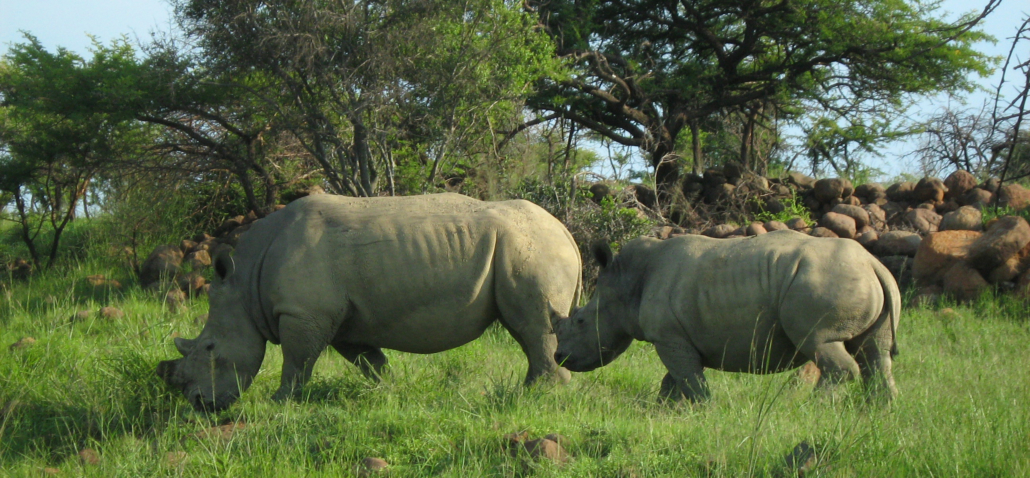
Rhino in the Nambiti Private Game Reserve
There are two distinct areas in KwaZulu-Natal where you can enjoy a safari. The reserves in the Zululand/Maputaland area are characterised by sub-tropical, lush bush, and mild temperatures in the winter and hot temperatures in the summer. This area is also quite scenic, as it is quite mountainous, making the topography interesting. The Nambiti area is quite cold in winter and mild in summer and set in an area of rolling hills of savannah with clumps of trees.
Reserves to visit include, amongst others: Nambiti Private Game Reserve, Hluhluwe–iMfolozi Park, Mkuze Falls Private Game Reserve, Manyoni Private Game Reserve, Thanda Safari, Phinda Private Game Reserve, and White Elephant Safari.
Kwa-Zulu Natal Coast

Thonga Beach lodge on the north KZN Coasthis coastline, which continues into Mozambique, is one of the most beautiful on the continent. Long, sandy beaches, big breakers, subtropical vegetation, and easy access characterise this part of South Africa. There are areas along the coast that are built-up and very commercial and areas that are off-the-beaten track, quiet, and offer the visitor the luxury of long, uncrowded walks on the beach.
The northern part of this coastline is one of the best places to encounter Loggerhead and Leatherback turtles coming up onto its sandy beaches to nest. The coast also boasts famous coral reefs like Aliwal Shoal, Protea Banks, 7-Mile Rreef, and Leadsman Shoal. Virtually every little bay has a reef, which is often great for snorkelling and scuba diving.
As the floor of the ocean drops quite quickly to deep water, deep-water fishing is a great way to spend some time during your vacation, and the fishing is good to very good.
Battlefields of Kwa-Zulu Natal

Battle of Blood River
Parts of KwaZulu-Natal saw many battles between the Zulu tribe, the British, and the Boers. Some remarkable stories found their origin here, and with its beautiful scenery, make for a historically interesting and geographically scenic stay. The lodges in the area offer battlefield tours with experts that make the stories come alive and bring the past into the present for an hour or two. With the Drakensberg Mountains in the distance and the wildlife of the area adding an extra dimension to your stay, this is a great base to see and experience many of the activities and relax while surrounded by those things that make Africa unique.
Famous battle sites include Rorke’s Drift, Isandlwana, and Spioenkop. The area also has many memorials and a couple of museums.
Kwa-Zulu Natal Midlands

Views of the Midlands Meander
This area is characterised by green, rolling hills, offering a very pastoral experience. This is horse and cattle country, but has become famous for its arts and crafts, cuisine, accommodation, conference venues, historical places of interest, wildlife, and opportunity for adventure activities. This is a great place to unwind after a safari, take in your surroundings, enjoy a spa treatment, and just relax.
The Midlands stretches from Hilton in the south to Mooi River in the north, from the foothills of the Drakensberg in the west and Karkloof in the east.
Eastern Cape

Hole-in-the-wall on the Eastern Cape Coast
The Eastern Cape is a place where very diverse ecosystems meet. In the north and west is the arid and dry Great Karoo. On the south-west coast is the temperate Tsitsikamma Forest. The southern coast is rugged with numerous secluded bays, and the north-eastern coast is sub-tropical, with long sandy beaches, and is surrounded by rolling hills, while the interior is mountainous. The Drakensberg mountain range has its southernmost point in the Eastern Cape.
The Eastern Cape is home to the Tsitsikamma Forest, the Addo National Park, the Amakhala, Sibuya, Kariega, Lalibela Game Reserves, Shamwai, Samara, Kwandwe, and Pumba Private Game Reserve, as well as a smattering of other reserves. Game viewing is very different to that of the Kruger Park, as the vegetation is low bush, and small trees make it easy to spot game. It also provides the opportunity to spot the smaller mammals, including the Aardvark, Aardwolf, African wildcat, caracal, serval, mongoose, pangolin, and porcupine to name a few. Most of the reserves have spectacular scenery with mountains, valleys, ravines, rivers, and savannah plains. Even if you do not experience a particularly productive game drive, on the day, the scenery provides you with enough to feast your eyes on.
Jeffreys Bay is known as one of the best surf spots in the world. Close by is St Francis Bay and Cape st Francis, where long sandy beaches are the playground of the rich and trendy. As you travel up the coast, you will encounter spots like Hole-in-the-Wall that help you understand why this area is called the Wild Coast. The Wild Coast is also the scene of the “hotel-hopping” Wild Coast walk, where each day takes you along the scenic coastline, on beach walks, through small rivers, and even a ferry river crossing, all the while enjoying the comfort of a dinner and bed at your hotel at the end of the day.
Set in the Great Karoo, the historical town of Graaff-Reinet offers history, quaint shops, excellent restaurants and coffee shops, and the incredible Valley of Desolation and the Camdeboo National Park. Not far away is Cradock, another town rich in history, which has on its doorstep the Mountain Zebra National Park, created to protect the Cape Mountain Zebra. Cities like Grahamstown, Port Alfred, Port Elizabeth, and East London each have their own attractions.
Great & Small (Klein) Karoo
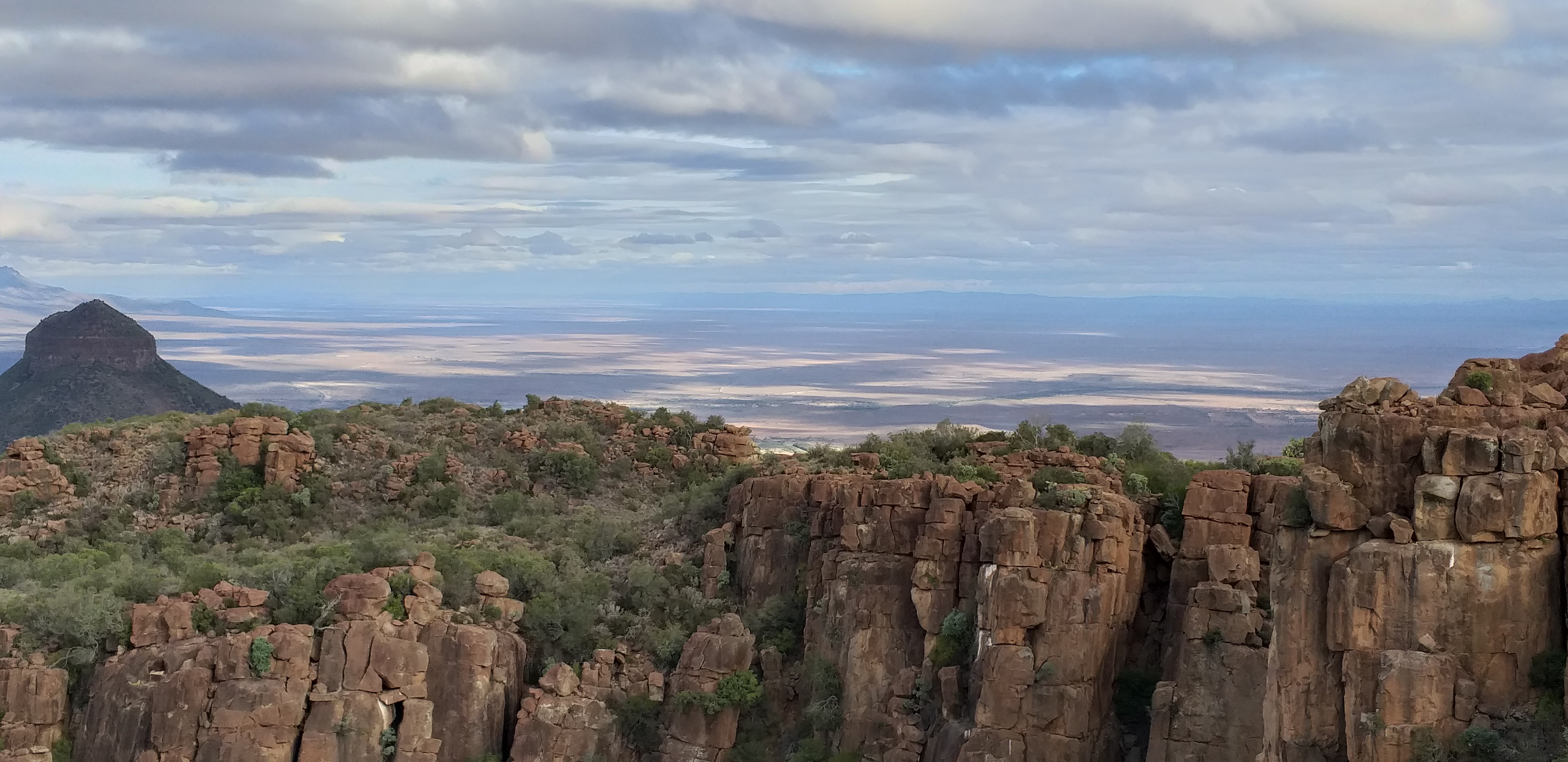
Valley of Desolation near Graaff-Reinet
The Karoo is the name given to the semi-desert region that spans parts of the Western, Eastern, and Northern Cape. It is thought to be the remnant of a great inland sea, and its many fossils seem to add credence to this theory. The area is characterised by mountains, large open plains, dry air, hot summers and cold winters, grasslands, low bushes, and small trees (Karoo bush), which get sparser as you move further north. The vegetation in the Karoo is unique, and used to support huge numbers of wildlife that lived in huge herds. Today, Karoo lamb is famous. While the Karoo has very few perennial rivers, it does possess lots of underground water.
The Karoo is divided into the Great Karoo and the Klein Karoo. The 400 000 km² Great Karoo cannot be precisely demarcated with the exception of its southern boundary, the Swartberg Mountain range. These mountains give way to large arid plains dotted with flat-topped hills, the Karoo Koppies. The Klein Karoo is well demarcated by the Swartberg Mountains in the north and the Langeberg and Outeniqua ranges in the south.
While it is 290 km in length, it is only 60 km at its widest point. Parts of the Klein Karoo receive quite a bit more rain than the Great Karoo. It is an area characterised by mountains, Karoo fynbos, remnants of volcanic eruptions, and the fault line that lies along the southern edge of the Swartberg Mountains. These are the reasons for the red cliffs of Calitzdorp/Oudtshoorn and the Cango Caves. The unofficial rock-climbing capital of Montagu and the ostrich capital of the world, Oudtshoorn, are but two of the quaint towns in the Klein Karoo.
Gauteng Province (Johannesburg & Pretoria)

Union Buildings in Pretoria
Gauteng is the economic hub of South Africa. Its two biggest cities are Johannesburg and Pretoria, but the whole province, South Africa’s smallest, is virtually all built up.
Johannesburg is distinct in many ways, but two of the least well-known are that it is the only major city in the world that does not have a major river flowing through it, and it is the largest man-made forest in the world. Johannesburg came into being during the Witwatersrand Gold rush, and from these humble beginnings, has grown to be the seat of business in South Africa and the wealthiest.
Rapid urbanisation is engulfing Johannesburg, which is struggling to keep up with the supply of services, housing, roads, and infrastructure. Millions of people from Zimbabwe, Zambia, Mozambique, and elsewhere in Africa have descended on Johannesburg in search of economic opportunities, creating more pressure on an already stretched infrastructure. The result is high crime rate, xenophobia, overcrowding, poverty, a degree of lawlessness, and a high unemployment rate.
Pretoria is South Africa’s legislative capital, and houses the Union Buildings, where the offices of the president are located. The Union Buildings, designed by Sir Herbert Baker, are impressive and offer expansive views on the city itself. Pretoria is experiencing the same challenges as Johannesburg, but to a lesser degree.
With over 22% of the population living in 1,5% of the area of South Africa, Gauteng is crowded and busy. It is a land of shopping malls, hotels, office blocks, and very upmarket suburbs juxtaposed by some of the poorest “locations” in the country.
The Overberg

The Overberg in the Western Cape
Sandwiched by the Hottentot Mountains just outside of Cape Town to the west, and the Garden Route to the east, this area that extends to the Atlantic and Indian Oceans in the south, also boasts the southernmost tip of Africa, Cape Agulhas. Mainly farmland, it produces huge quantities of wheat, other grains, and fruit.
Hermanus is known to be the site of the best land-based whale watching in the world, as the high cliffs afford excellent views of the impressive Walker Bay where Southern Right, Humpback, and Bryde’s whales come to give birth to their young. Gansbaai, now famous for its shark-cage diving, is reasonably close as well.
Safaris in the Western Cape

Oryx on Sanbona
A newcomer to the safari game in South Africa, the Western Cape, due to its very different vegetation, also offers a very different safari experience. The carrying capacity of the land is much less than the reserves in the northern part of South Africa, so large herds are not possible, and the populations have to be very well managed, so as not to stress the land. The vegetation, similar to the Eastern Cape, is less dense and lower, making it easier to spot game.
The reserves are geographically more exciting, with mountains, gorges, ravines, and rivers adding interest and variety. This, together with the fynbos, provide a beautiful environment to appreciate Africa’s wildlife. While some of the reserves have the Big 5, it is my opinion that the focus of the Western Cape reserves should centre around the smaller, lesser seen species that are more easily spotted in this environment.
South Africa is a bucket list destination. Contact Q2 Travel to help you tick of your South Africa box.
GENERAL INFO & HISTORY

South Africa Flag
South Africa is about five times bigger than the UK and eight times smaller than the USA. It boasts the largest European population outside of Europe and Indian population outside of India. Culturally, it is very diverse. Together with the diverse cultural heritage, South Africa also has a new culture developing amongst the born-free youth.
South Africa, even though it is facing tough economic challenges, remains one of Africa’s economic power houses. With a well-developed infrastructure, fertile lands, natural beauty, mineral wealth, strong tourism sector, and strong manufacturing sector, it is the continent’s most promising nation. It offers the tourist an eclectic mix of old, new, primitive, sophisticated, colonial, and modern, all in one country.
The country has 11 official language, of which English is the most used in the business and tourism sectors.
Brief History
The original inhabitants of South Africa were the Khoisan people. The name Khoisan is the collective name for the San people (hunter-gatherers) and the Khoikhoi people (livestock herders). It is widely believed that they lived as far south as the Cape Peninsula from about the year 0 AD.
The Bantu peoples moved south from west-central Africa, reaching southern Africa sometime in between 0 and 900 AD. Some tribes settled in the north-eastern, some in the eastern, and some in the central parts of the area that is now South Africa, Lesotho, and eSwatini. These tribes displaced the Khoisan people who moved to the more arid regions of southern Africa.
Between the years 900 to 1300 AD, the Kingdom of Mapungubwe was the first and became the largest kingdom in southern Africa.
While Bartholomew Dias was the first European to explore the coast of South Africa in his attempt to find a trade route from Europe to India, he only ventured as far as the Great Fish River. But, he did name the southern coast of Africa, the Cape of Storms. It was over a decade later that Vasco Da Gama rounded the Cape and proceeded to sail along the east coast of South Africa, which he named Natal. He sailed via Zanzibar and succeeded in his quest to reach India, effectively opening the Cape Route.
The 6th of April 1652 is significant in South African history, as this is the day that Jan van Riebeeck anchored his fleet in Table Bay. The Dutch East India Company had dispatched Jan van Riebeeck to establish a colony to supply their trading ships travelling between Europe to Asia with fresh food and water.
The Khoisan stopped trading with the settlers, and the fledgling colony was forced to import farmers from their home country to grow supplies for the trading ships. The colony started to expand, and some moved north, displacing the Khoisan people. As the farming operations expanded, so did the need for workers. As Jan van Riebeeck was reticent to enslave the Khoisan, he imported over 70000 slaves from the Dutch colonies in Asia, east Africa, Madagascar, and Mauritius. Needing more workers, van Riebeeck then relented and enslaved the Khoisan people. As is inevitable, the Dutch, Khoisan, and Malay slaves interbred, and their descendants became known as the Cape Coloureds and Cape Malays.
The Dutch were joined by the Germans and the French Huguenots, Protestant Calvinists, who fled France amidst religious persecution. The French invaded the Netherlands in 1794, and the British seized the Cape Colony in 1795 to stop the French getting control of the colony, only to give it back to the Dutch in 1803 and get it back again in 1805 after the Napoleonic Wars. In 1815, the Dutch were paid 6 million pounds, and the Cape Colony was officially British. They immediately banned the Dutch language, which was one of the motivators for the Dutch settlers (Boers) to “trek” inland away from British rule. In 1820, about 5000 settlers landed in the Cape and ended up settling in the Port Elizabeth/Grahamstown area.
The British were essentially interested in the Cape Colony to protect the trade route between England and India, but this brought them into border conflicts with the Boers.
In the 1820s, the Zulus, under the leadership of Shaka Zulu, embarked on a massive expansionism drive, killing all those in the way or making them slaves. This period, known as the Mfecane, saw between one and two million people lose their lives. The displaced tribes warred with their neighbours, causing the whole region to go through a period of great upheaval. It was during this period that Lesotho and eSwatini were formed.
The relatively small numbers of Boers that trekked inland during the early 19th century, were joined by much larger numbers of Boers in the 1830s. The Boers trekked from the Cape inland in what has become known as the Great Trek. The reasons for the Great Trek were many, but included the banning of the Dutch language, the cultural differences, and the banning of slavery. The Dutch farmers had invested heavily in slaves, and this would have meant huge financial losses.
The Boers would form the South African Republic (the Transvaal), the Orange Free State, and Natalia. The South African Republic became an independent state in 1952 after the First Boer War, and was relinquished after losing its battle with the British in 1902. The Orange Free State became a Boer Republic in 1854 after the British withdrew from the area. This republic also lost to the British during the Second Boer War and became known as the Orange River Colony. Natalia was defeated by the British in 1844 and was renamed Natal.
In the meantime, the Cape Colony started expanding east, which brought them into conflict with the Xhosas. The Xhosa Wars, nine in total, were fought between 1779 and 1879, the end result of which was the Xhosa area being incorporated into the British territory.
In the 19th century, the Cape Coloureds trekked northwards to escape the Cape Colony’s influence. They were joined by some Khoisan, some Bantu tribesman, and some white settlers. They moved into what is the Northern Cape Province. This grouping of people became known as the Griquas and the area they settled in as Griqualand. Diamonds were discovered near present-day Kimberly, and in 1871, Griqualand was annexed by the British and renamed Griqualand West.
The Boer trekkers that formed Natalia, initially had a truce with the Zulu kingdom. The Zulu’s, however, continued to rustle cattle, and it was the slaying of Piet Retief and his men that lead to the Battle of Blood River, where a handful of Boers withstood the onslaught of about 5000 Zulu impis.
In 1879, the Anglo-Zulu war was fought at Isandlwana, resulting in the Zulu kingdom being annexed by the British.
While most of the Boers that took part in the Great Trek and their descendants settled in the Orange Free State, the Transvaal, and Natalia, some moved into the northern parts of South Africa. This brought them into conflict with the “Matabele”, who were eventually defeated and fled to southern Rhodesia (Zimbabwe).
It was the discovery of Diamonds in the northern Cape and gold on the Witwatersrand that would change the history of South Africa significantly. By the 1870s, the diamond mine at Kimberley was producing about 95% of the world’s diamonds. The revenue from these diamonds meant that the Cape Colony was no longer dependant on monetary support from Britain, and this led to the Cape Colony becoming self-governing in 1872. It was the formation of De Beers Consolidated Mines by Cecil John Rhodes that would influence South Africa’s fortunes to the present day.
In 1886, the discovery of gold on the Witwatersrand, lead to the gold rush, the establishment overnight of Johannesburg and the influx of people from all over the world. The seams of gold, however, were deep underground, and capital and expertise were needed to mine it. Most of the industrialists that opened these deep-level mines were Jewish, and their success attracted many Jewish people to move to South Africa.
In 1877, the British annexed the South African Republic, to gain control over the wealth derived from gold, precipitating the first Anglo-Boer War. The British were defeated near Majuba in Natal and the South African Republic regained its independence. 12 year later, the British demanded that the foreign white people, who had been excluded from the political life of the republic, be given voting rights. The Kruger government refused and demanded that the British withdraw the troops from their border. The failure to do this precipitated the Second Anglo-Boer War.
The successful outcome of the war for the British allowed them to start the process of unifying all the colonies into one country, the Union of South Africa, which was realised in 1910. The Union was governed by a Governor-General on behalf of the British monarch. The first Governor-General was General Louis Botha from the South African Party, which was essentially pro-British. Disgruntled Boers split from the South African Party and formed the National Party. The National Party promoted separate development and the interests of the Afrikaner. In 1924, the National Party/Labour Party coalition won the elections and General Barry Hertzog became the Governor-General. Almost immediately, Afrikaans replaced Dutch as an official language alongside English.
In 1913, the Natives Land Act put 90% of the country into the hands of the white people, and allocated 8% to the black people. This entrenched the policy of separate development and racial discrimination, and in addition, black people were not allowed to vote. This act was augmented in 1970 with the Homeland Citizens Act, which allowed the government to forcibly evict black people from the urban centres and resettle them in Bantustans, supposedly the original areas where the tribes came from.
In 1948, the National Party won the election and ushered in an era of Afrikaner Nationalism. Dual citizenship with Britain was ended, the Naval base in Simonstown was taken from the Royal British Navy, and symbols of British rule were systematically done away with. The policy of separate development for black and white people was intensified and movement of black people around South Africa was restricted through the Dompas system. 1948 to 1994 would become known as the Apartheid Era.
In 1960, South Africa was withdrawn from the Commonwealth after a narrow referendum victory, which voted for South Africa to become a republic, which it did on 31 May 1961. The National Party would rule the Republic of South Africa until 1994.
Over the next decades, the militarisation of the black people in South Africa would occur. It would be vigorously suppressed by the Government. Liberation movements would be formed of which most were banned, the most notable being the African National Congress. Backing for the anti-apartheid movements would, by large, come from the communist-bloc countries, led by Russia, which played into the governments narrative that they were protecting the country against communism. International pressure would mount on the South African government in the form of embargos and sanctions.
While sanctions would have an effect on the economy of South Africa, it also forced South Africa to develop in such a way as to become as independent of the international community as possible. This industrialisation propelled South Africa to become the economic powerhouse of Africa, and as the movement of money outside of the country was restricted, the sophisticated banking system was developed.
A combination of many factors, including civil unrest, international pressure, the fall of the Soviet Union, and many more, led to President de Klerk unbanning the African National Congress, South African Communist Party, and the Pan Africanist Congress, and released Nelson Mandela from imprisonment in 1990. In 1992, 68% of the white population of South Africa voted for democracy in a national referendum. Negotiations that stared in 1990 would take three years, and would culminate in a new draft constitution. This would pave the way for the first multi-party democratic elections in 1994. It was won by the African National Congress, and Nelson Mandela was sworn in as the first black President of South Africa.
Now a democracy, South Africa would enjoy the lifting of economic sanctions and experience modest economic growth. The challenges to provide schooling, houses, job opportunities, and skills to the majority of the population that had been denied these would put an enormous strain on the South African economy. The policy of BEE (Black Economic Empowerment) would see thousands of skilled white people being replaced by minimally skilled to unskilled black people in all sectors of society, especially as civil servants. Tens of thousands of white people would immigrate, leaving a skills vacuum.
This policy, issues around land redistribution, lawlessness, crime, and service delivery, coupled with rampant corruption under the Zuma administration would virtually bring South Africa to its economic knees, where it currently finds itself. While BEE is an attempt to address the inequalities that arose due to the Apartheid policies, it is a thinly disguised form of racism, and in the opinion of the writer will in the future most probably be looked back on as almost as damaging to South Africa as Apartheid was.
Money
South Africa’s unit of currency is the South African Rand (ZAR). All transactions in the country are done in ZAR and other currencies are not accepted as legal tender.
Reasons To Tour South Africa
- South Africa is home to some of the premier game reserves and national parks in the world, including Kruger National Park
- Here you can enjoy a combination of experiences – nature, history, culture, wildlife, all in one country
- The wonderful climate makes South Africa a year-round travel destination
- Great value for money
- An ideal family destination
Accommodation in South Africa
South Africa is home to some of the finest accommodation in the world. From the laid-back city of Cape Town, the bustling business hub of Johannesburg, the surfing paradise of Durban, the lush wilderness of the Garden Route, the wide open spaces of the Northern Cape and the tranquil beauty of the Cape Winelands, guests will find South Africa accommodation to suit all needs, whether for business or pleasure.
Climate
South Africa has a wonderful climate with a wonderful warm sunshine all year round. Because the country is located in the southern hemisphere, the seasons are the opposite of those in Europe. Here winter means summer! This makes South Africa the ideal destination if you want to escape winter in Europe.

Cape Town and the southern part of the Western Cape have a Mediterranean climate, with hot summers and warm winters. Durban and the coast of KwaZulu-Natal, on the other hand, are subtropical, with a great deal of sunshine throughout the year!
Summer: November – February
In general, the South African summer, from November to February, is characterized in the greater part of the country by hot weather with thunderstorms during the afternoon, which quickly clears up. A warm, unique smell of earth is released into the air during clearing!
Autumn: March-May
Autumn runs from March to May and offers the best weather. The rainfall is limited, throughout the country, and it is hot but not too hot. It gets cooler as time goes by. In Cape Town, autumn is fantastic, with hot, sunny days and warm, gentle evenings. Most people spend their evening outside on a cafe terrace.
Winter: June – August
For observing wild animals, the clear, dry days of South African winter are the best. Because of the sparse vegetation, it is easier to see the animals. Winter in the higher areas is characterized by dry, clear, sunny, cool days and cold nights. Certainly, do not forget to bring warm clothing during this period! The lowveld and the coast of Maputoland have fantastic weather in the winter with sunny, warm days, it rarely rains or is windy. In the Western Cape, the most rain falls in the winter and there may be a few days with gray, cloudy, rainy weather, but always alternating with beautiful sunny days. High in the mountains of the Drakensberg and around the Cape, it may snow. Skiing is possible in a few places.
Spring: September – November
Spring is also a time of renewal in South Africa. Everywhere you see bright green buds appear on the trees and young grass get along in the field. But nowhere is spring more spectacular than in the Cape. Huge quantities of plants then cover the plains with a garment of flowers, in all colors of the rainbow. Annually, many South Africans undertake a pilgrimage to admire the flowers of Namaqualand in the Western and Northern Cape.
Best Time To Travel
South Africa is a good travel destination all year round.
The best travel time depends on the activities you want to undertake:
- For safaris, the best travel time is the end of spring, August, and October.
- You should also take into account the periods for whale watching. The southern whales swim off the coasts from mid-June to the end of October. The humpback whales from August to December.
- Diving and surfing are best in winter, from June to September. The other periods are also possible.
- If you are a nature lover, the flowers are at their best in August and September.
- Whitewater rafting on the Cape is best done at the end of winter. In KwaZulu-Natal in summer, from late November to February.
- Mpumalanga and Limpopo are good destinations throughout the year.
- Spring and autumn are the best times to wander around because the summer may be too hot.
- In the Drakensberg, you have to take into account thunder in the summer, which can be dangerous. There is a reasonable chance of snow in winter.
- Winters can be wet in the Cape.
- If you are a bird lover, the arctic migratory birds arrive in November and the African migratory birds usually arrive in mid-October.
- If you want to go skiing, snow is guaranteed from June to August.
- If you are someone who wants to enjoy the beach all day, then the middle of summer is the best time, although the rest of the people are there too. The beaches in northern KwaZulu-Natal are warm and sunny, even in the middle of winter.

Culture
The Rainbow Nation
Tourists in South Africa have the opportunity to discover the real Africa, to learn about the people and their way of life, culture, and history.
South Africa is now known for its fascinating cultural heritage.
You can also discover the links with the distant ancestors of mankind.
South Africa has archaeological sites such as the Sterkfontein caves at Krugersdorp in Gauteng and Makapansgat, at Mokopane (Potgietersrus) in the Limpopo Province, where evidence was found of very early human settlements of more than three million years ago.
During a visit, you will discover why the country is called the Rainbow Nation.
You will have the opportunity to view the colored mosaic that composes South Africa’s contemporary society.
The reconciliation and mutual respect that is now spreading throughout South African society help the country to strengthen its multi-ethnic origins.
This South African cultural mix consists of many different groups.
San San
Hunter collector San is the original inhabitant of South Africa. Few of these original inhabitants are left, but the evidence of their years of presence has been preserved in the murals found in various caves.
These people lived in small groups or families with few personal possessions. Because they had no idea of their property rights, in the vast vast area they lived in, there were no social conflicts.
The San still live in their traditional way in the remote areas of South Africa such as the Kalahari desert.
The Khoikhoi
A step further on the ladder of history, we find the Khoikhoi, cattle, and shepherds, who formed polygamous communities led by a captain.
They lived in round huts of wood and mats that could easily be broken down when looking for new meadow areas. The Khoikhoi were the first people to meet the Dutch pioneers at Table Bay.
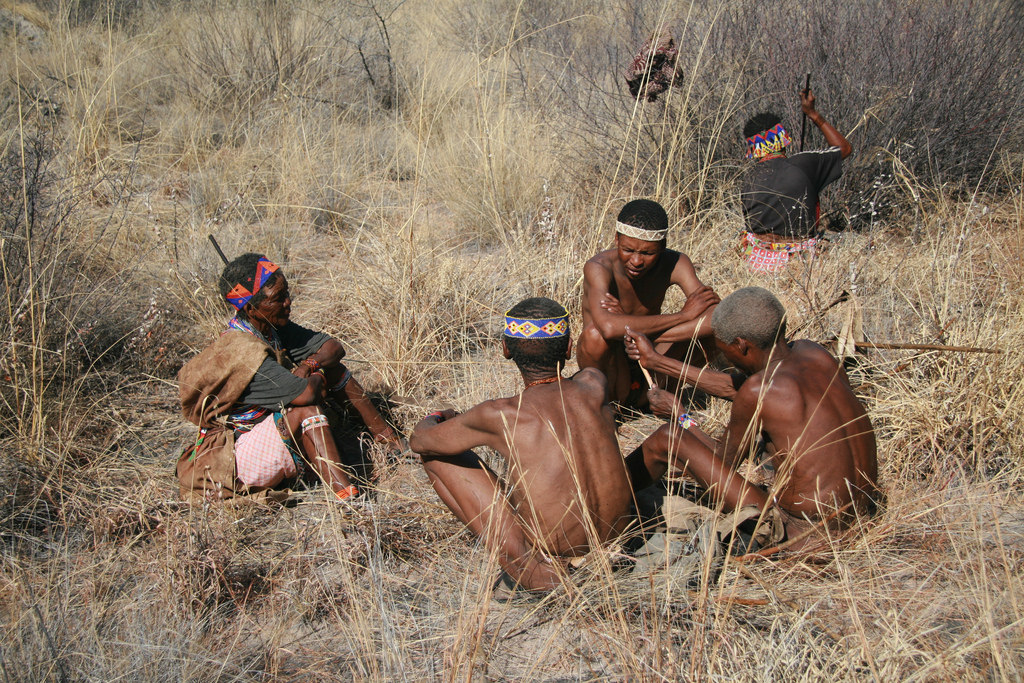
The Dutch called them “Hottentots”, probably because of the clicking noises that they made when speaking and which they misunderstood as stuttering.
South Africa’s majority population
The majority of the South African population consists of black Africans who are proud of themselves and the many facets of their ethnological origins.
These Africans can be divided into different ethnic groups that settled in different areas of the country:
- Xhosa »Eastern Cape
- Zulu» KwaZulu-Natal Province
- Ndebele and the Shangaan »Mpumalanga
- Southern Sotho» Free State
- Northern Sotho (or Pedi ) »Limpopo
- Tswana »North-West Province
- Venda» Limpopo Province
- Swazi »KwaZulu-Natal and Mpumalanga on the border with Swaziland
In urban areas, most Africans have taken over the western way of life, but in the countryside, there are still many remnants of their original traditions.
Lesedi Cultural Village in Lanseria, Gauteng, is a multicultural African village less than an hour’s drive from Johannesburg. It consists of a number of different farms and villages.
Each visitor is accommodated as a guest with a traditional African family to learn about their culture and way of life. The evenings are spent around the campfire with traditional dances, stories, and chants.
Contributing to the “Rainbow”
The first Europeans to set foot in South Africa were the Portuguese.
In the course of time, the Cape attracted settlers from the Netherlands, France, Germany, and England. Of the 56 million people in South Africa at present, there are about six million of European origin.
Slaves from Madagascar and Java were also brought to the Cape, while contract workers from India worked on the sugar-cane plantations of KwaZulu-Natal.
Despite its relatively small size, the Jewish community plays an important role in many areas of South African life.
The Chinese and Greeks add a further, valuable dimension to the South African cultural mix!
Contact Us & Sitemap
Latest Articles
- African Safari Tours – Part 4 – Big 3 African Transfrontier ParksDecember 9, 2019 - 7:57 am
 African Safari Tours – Part 3 – Zimbabwe’s trio of safari must dos.November 18, 2019 - 7:07 am
African Safari Tours – Part 3 – Zimbabwe’s trio of safari must dos.November 18, 2019 - 7:07 am African Safari Tours – Part 2 – Unique Animals of AfricaNovember 14, 2019 - 6:52 am
African Safari Tours – Part 2 – Unique Animals of AfricaNovember 14, 2019 - 6:52 am African Safari Tours – Part 1November 13, 2019 - 5:27 am
African Safari Tours – Part 1November 13, 2019 - 5:27 am African ToursSeptember 26, 2019 - 11:25 am
African ToursSeptember 26, 2019 - 11:25 am


